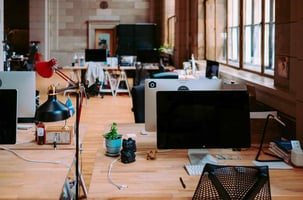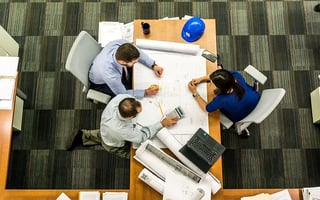If your business is in the process of redesigning its office space to incorporate an open plan...
The Psychology Of Office Layout
“If you live and work in an environment that is stimulating, then your mind is open to fresh, new ideas. If, however, the environment is dull and confining, then your creativity is stifled.” (Dr. Tina Seelig - inGenius: A Crash Course in Creativity)
Good office space layout isn't just 'nice to have'. When you want to get the best out of the people you employ, the psychology of office space really matters. Making the most of people's talents involves making sure they're happy, safe and comfortable. It means showing them their welfare genuinely matters to you. And it means creating an office layout design that is just as inspiring as it is practical and fit-for-purpose.
The proof? As one Dutch study found, (https://www.emeraldinsight.com/doi/abs/10.1108/14725960310807944) plenty of people take sick leave simply because they're not comfortable at work. It also revealed how people are less likely to work hard in an environment that's not fit for purpose. It has also been proven that the more personal control a person has over their workspace, the happier they are at work. (https://www.sciencedirect.com/science/article/abs/pii/S0272494405000538).
How can you achieve that magical balance between practical and attractive, a balance that drives better work, enhanced productivity and even brighter ideas? Here are some intelligent tips for creating an office design that really does positively impact the happiness of your employees, boosting their productivity in all sorts of exciting and sometimes unexpected ways.
How to get office space layout wrong – The office cubicle
What are the different types of office layout, the most common ways to design an office, and what's wrong with them? In life as in work, it's often wise to pin down the wrong way to do things because it helps you to get things right! So what's the wrong way to design an office space? Roll back time to the 1960s, when what is possibly the worst ever innovation in office design was invented. Introducing the cubicle, a brilliant idea that soon went horribly wrong.
The original cubicle was called an 'Action Office, invented by the American Robert Propst. He was convinced that excellence in office work was closely tied to the physical environmental, which could enhance a person's capabilities. His innovative standing desk communications centre was designed for making telephone calls. It was available in a choice of bright colours and the elements could be arranged by each user to satisfy their own needs and match their personality.
Sadly the idea's true potential was never realised. Instead businesses used the idea to create crowded battery hen-like workplaces that isolated people from each other, providing them with as little space as possible. But some businesses, including call centres still use cubicles to this day.
Getting office layout design wrong – Open plan done badly
The very opposite of the cubicle, the open plan office, was also dreamed up in the '60s, this time by the student architect Frank Duffy. So-called 'burolandschaft', AKA office landscaping, created less formal, more random layouts involving different sized and shaped working zones.
This style of office design also remains popular and also has problems of its own, including high levels of noise, high levels of distraction, poor security, problems keeping people adequately warm or cool, and illnesses that spread like wildfire. Coupled with no personal space and little or no privacy, it isn't always ideal.
Interestingly, though, an open layout does have a positive effect on communications. When the big pharma giant GlaxoSmithKline rejected cubicles in favour of a more open layout, email traffic plummeted by an impressive 50% simply because people found it easier to talk in person.
Workspace design psychology - Tips for a perfect office layout plan
Add real greenery – it's a fact: plants make humans feel good. They reduce stress, boost productivity, reduce sick leave and absence, clean the air, reduce noise and can even increase creativity.
It's great when you're in the flow – An open layout can mean too many distractions. The solution is flow zones, quiet areas of an office where people can get into the flow and stay peacefully in it for as long as they need. Your flow zone could be as simple as an office with a door within an otherwise open plan design.
Privacy is vital – It can be depressing when you need peace, quiet and privacy but there's none available. It's also stressful being in a constantly noisy environment when you're trying to focus, concentrate or talk to someone on the phone. As well as flow zones, create quiet spaces where people can get important things done without interruption.
Include lots of lovely natural light – Humans need a certain level of vitamin D in their daily lives, which we get from sunshine. If you've ever worked in an office without windows, or a desk facing away from them, you'll know how unpleasant it feels, being so isolated from the real world. While natural light indoors doesn't provide us with vitamin D, it certainly helps morale. It's good to let natural light to stream into your premises at every opportunity, unimpeded, and ensure everyone's desk is placed in a position to make the most of it. Because natural light means you use less fluorescent lighting, it's even better. If you're short of natural light, you can mimic it with daylight light bulbs.
Create sociable circles – It happens perfectly naturally at parties and gatherings. Humans love to congregate, and that's when we have our best ideas. The same goes for sitting in a circle, perhaps because it mirrors sitting round a campfire, something we've been doing for millions of years. If you go for an open office layout, arrange desks in circles according to their owners' function and you'll maximise valuable collaboration.
Let people be themselves – “I am not a number... I'm a free man”. So says the legendary Patrick McGoohan in the classic 1960s TV series, The Prisoner. He's not alone. None of us likes to feel we're a mere number. In fact research in 2010 revealed how workers who were allowed to personalise their workspace with plants and pictures were up to 32% more productive than those who were not allowed to personalise their space. It makes sense when most of us spend at least eight hours a day, five days a week at work.
Provide choice – Most of us, given the choice, would love the opportunity to work from home now and again, or work flexible hours. If that happens at your company, you need to factor it into the way you design your office space, perhaps providing hot-desking facilities for people who work remotely or sales staff who usually operate out of the office.
At the same time you need to take into account the fact that people appreciate being in control of their environment. Otherwise agile working can leave employees feeling unhappy because they don't have a 'home', a desk of their own that works to support their activities. There's an intelligent balance to strike between enough desks and chairs, too few and too many. Luckily today's 'wayfinding systems', often apps, are designed to help people find the perfect space to work, as well as find people they need to track down.
Deliver equity – Fairness is incredibly important. An old-school office layout plan emphasises the traditional power and status-based corporate hierarchy, giving senior people more-comfortable chairs, better access to natural light and windows. Modern businesses reject this old approach. In a contemporary office setting equality drives better interaction between people at different levels.
Get the temperature right – Some of us run hot, others cold. It's vital to get the temperature right so everyone is comfortable and can work efficiently. Heat in winter is important, but in a warming global climate air conditioning in hot weather matters just as much.
Provide comfort – It sounds blindingly obvious, but if someone's chair or desk makes working less than comfortable they will suffer, and so will their work. It’s sensible to provide proper, ergonomically designed furniture if you want to enjoy better productivity and staff retention.
Harness the power of colour – A plain cream or white wall can soon feel a lot like an institution, depressing and boring. Different colours have different effects on the way we feel. So it seems wise to create an office environment that uses colour to inspire and breathe new life into people. Colours have a profound impact on productivity and positivity. Natural tones like greens and blues can improve efficiency and focus, and yellows can boost your creativity, optimism and energy.
Be safe – Safety at work is about a lot more than fixing trip hazards. In the office it also means emotional safety. Modern office designs positively promote strong teams, and that helps people feel safe and secure in their jobs. If you can go the extra mile and actually create a workspace that acts like a neighbourhood as well as a place where work happens, you'll be able to build stronger, more cohesive teams of confident people. And that almost always means a better bottom line.
Is your office layout plan letting you down?
If you think you could do better business with a fresh new layout, we'll be delighted to help you achieve your goals. If you need finance, we provide it. Let's talk!



